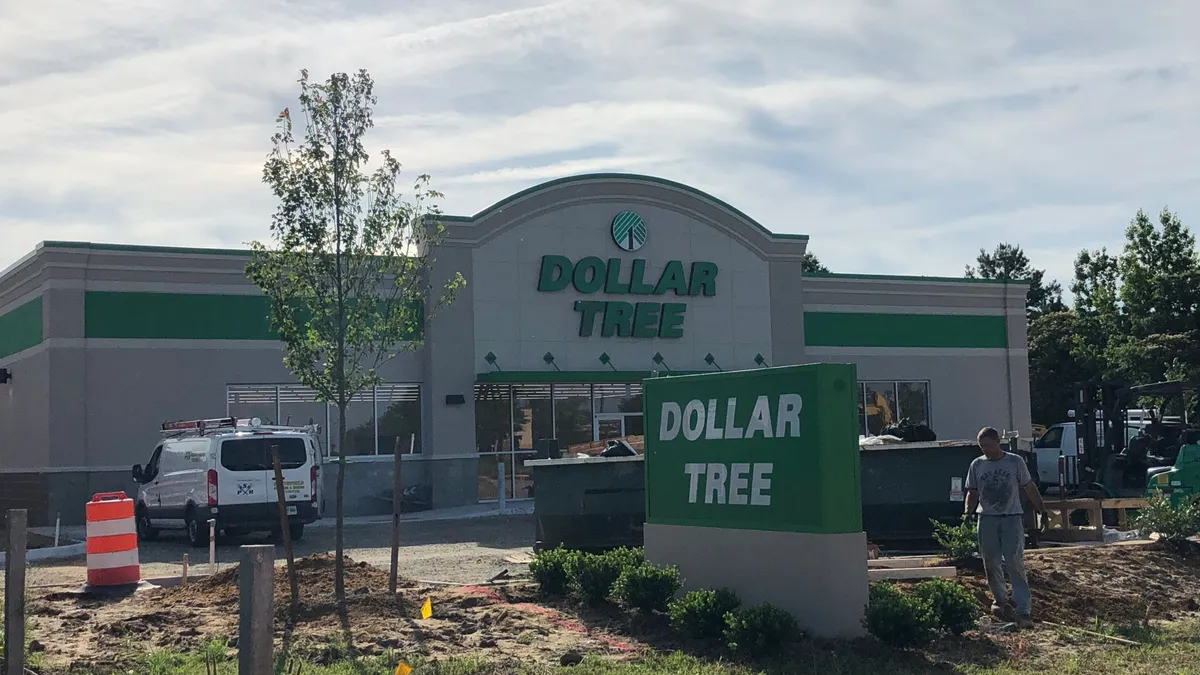Dive Brief:
- Dollar Tree’s consolidated Q2 net sales rose 0.7% to $7.4 billion year over year, the company said in a Wednesday earnings statement. Second quarter same-store sales at the company’s namesake banner were up 1.3%, but were flat for Family Dollar. Net income for the second quarter was $132.4 million.
- With Q2 results falling short of the company’s expectations, Chief Financial Officer Jeff Davis said lowered full-year guidance reflects a more reserved sales outlook and the costs of converting former 99 Cents Only stores to the Dollar Tree banner.
- The company also said higher costs to manage and settle legal claims arising from in-store accidents and incidents is affecting profitability. Dollar Tree’s updated full-year outlook now forecasts net sales ranging from $30.6 billion to $30.9 billion — down from $31 billion to $32 billion — and comp growth in the low single digits for the enterprise and its two business segments.
Dive Insight:
Dollar Tree, like its main rival Dollar General, is being adversely affected by persistent macroeconomic consumer pressures. Simultaneously, it’s also in the midst of a long-term business transformation, Telsey Advisory Group analysts led by Joe Feldman said in a note. Still, “we are disappointed by weak 2Q24 results and the magnitude of [the] 2024 guidance cut,” Feldman said.
Davis said during Wednesday’s earnings call that comparable sales softness for the company’s Dollar Tree segment was mostly on the discretionary side of the business. Dollar Tree has a broader customer base with more middle- and upper-income households. But this quarter, inflation, interest rates and other economic pressures began to affect the buying behavior of that demographic.
In contrast, Family Dollar’s customer base is made up of more lower-income households. Additionally, 40% of the banner’s customers are eligible for government assistance. Chief Operating Officer Mike Creedon said reduced SNAP benefits during Q2 drove a 60-basis-point comp headwind for the segment, an improvement from a 280-basis-point impact in Q1.
In the spring, the company announced plans to close nearly 1,000 Family Dollar stores. Later, the company said it was exploring a spinoff or sale of the banner. As of August, the retailer said it had closed about 655 locations with plans to close 45 more through the end of its fiscal year.
“As we have noted before, one of the problems with Family Dollar is that prices are not particularly competitive and this situation has worsened as other players, like Walmart, are investing more in keeping their own prices low,” Neil Saunders, managing director of GlobalData, said in emailed comments. “This has lost Family Dollar even more customers. The dilemma for Dollar Tree is how much corrective action to take and how much investment to put into a business that it ultimately wants to separate out.”
As it moves to shrink its Family Dollar footprint, the company is expanding in the Southwest and California following the acquisition of about 160 leases from 99 Cents Only stores after that company’s April bankruptcy and liquidation. Creedon said Wednesday the company had reopened 85 former 99 Cents Only stores as Dollar Trees, with an additional 20 slated to open this week and about another 56 to reopen before year end.
While Saunders called the company’s most recent performance “an incredibly weak set of results,” many of the problems center around Family Dollar and he noted that Dollar Tree’s push toward a broader multi-price offering is driving an improved assortment and larger basket sizes, which is offsetting how the consumer economy is affecting the discount retailer’s performance. “From our data, customers have responded well to this and while some are still limiting what they spend, others are finding the more comprehensive selection is allowing them to transfer more of their budget to Dollar Tree,” Saunders said.
Regarding the multi-price initiative, Creedon said “the customer response is validating our strategy because our biggest challenge now is keeping up with the demand for the new assortment.” Creedon said comps for the 1,600 Dollar Tree stores converted to the retailer’s newest multi-price assortment were up 4.6% in Q2 versus less than 0.5% at stores with other formats.















